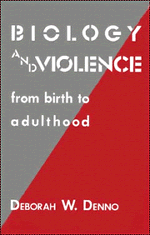Book contents
- Frontmatter
- Contents
- Foreword by Marvin E. Wolfgang
- Preface
- Introduction
- 1 Biological and environmental influences on crime
- 2 Violent criminals as children and as adults
- 3 Intelligence and crime
- 4 Biological and environmental predictors of crime
- 5 Case studies of violent and career criminals
- 6 Biology and responsibility
- Appendix: Selection and distribution of Biosocial Project variables
- References
- Author index
- Subject index
Introduction
Published online by Cambridge University Press: 04 August 2010
- Frontmatter
- Contents
- Foreword by Marvin E. Wolfgang
- Preface
- Introduction
- 1 Biological and environmental influences on crime
- 2 Violent criminals as children and as adults
- 3 Intelligence and crime
- 4 Biological and environmental predictors of crime
- 5 Case studies of violent and career criminals
- 6 Biology and responsibility
- Appendix: Selection and distribution of Biosocial Project variables
- References
- Author index
- Subject index
Summary
In recent years, rapid growth in the biological sciences has greatly increased knowledge about the complexity and diversity of human development. Such advancements have propelled the study of a variety of social disorders, ranging from alcoholism to depression and psychiatric disturbance. Relatively few studies, however, have examined biological links to criminal behavior – a topic that sparks both controversy and criticism in an area of study that has depended, for the most part, on sociological and environmental explanations of even extreme violence.
Research on biological features of criminal behavior, and its accompanying controversy, is not new. Over a century ago Cesare Lombroso, an Italian physician, suggested that some individuals were “born” criminals with distinct physical features that he thought characterized primitive men, such as sloping foreheads, long arms, and flat feet (Lombroso, 1968; see Wolfgang, 1955, for a review of Lombroso's work). Lombroso's research was severely and justifiably criticized in both substance and methodology (Wolfgang, 1955). His major formulations, however, portrayed an originality apart from nineteenth-century thought and influence and, appropriately or not, they have had a large impact on modern criminological theory and studies of crime.
As in history, current interest in biological correlates of behavior has often been perceived synonymously with radical reductionism, the philosophy that all behavior can be explained in biological terms. Edward O. Wilson's introduction of “sociobiology,” for example (Wilson, 1975, 1977; Lumsden and Wilson, 1981), has generated concerns by some that all individual differences will be biologically interpreted, thereby fueling prejudices among the different sexes, races, and social classes (Kitcher, 1985; Montagu, 1980).
- Type
- Chapter
- Information
- Biology and ViolenceFrom Birth to Adulthood, pp. 1 - 6Publisher: Cambridge University PressPrint publication year: 1990



